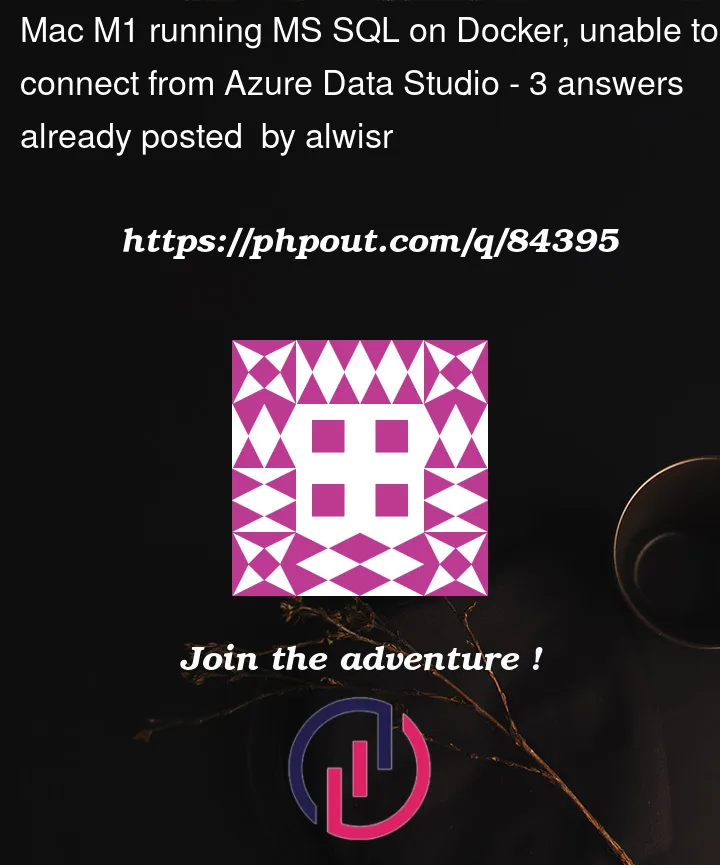Environment: MacBook Pro – Chip: Apple M1 Pro, macOS Monterey 12.2.1
How do I run a docker MS SQL (any version) on Mac M1 and connect from Azure Data Studio?
I was able to create a docker image of azure-sql-edge. Pod is running OK.
INFO: Connection opened from 127.0.0.1:57588 to 127.0.0.1:1431
YAML file is attached here.
Azure Data Studio Error:
Error: server as localhost 1433
A network-related or instance-specific error occurred while establishing a connection to SQL Server. The server was not found or was not accessible. Verify that the instance name is correct and that SQL Server is configured to allow remote connections. (provider: TCP Provider, error: 35 – An internal exception was caught)
Error: server as localhost without Port number
A connection was successfully established with the server, but then an error occurred during the pre-login handshake. (provider: TCP Provider, error: 0 – 40034080)
YAML:
apiVersion: apps/v1
kind: Deployment
metadata:
name: mssql-depl
spec:
replicas: 1
selector:
matchLabels:
app: mssql
template:
metadata:
labels:
app: mssql
spec:
containers:
– name: mssql
image: mcr.microsoft.com/azure-sql-edge
ports:
– containerPort: 1433
env:
– name: MSSQL_PID
value: "Developer"
– name: ACCEPT_EULA
value: "Y"
– name: MSSQL_SA_PASSWORD
valueFrom:
secretKeyRef:
name: mssql
key: MSSQL_SA_PASSWORD
volumeMounts:
– mountPath: var/opt/mssql/data
name: mssqldb
volumes:
– name: mssqldb
persistentVolumeClaim:
claimName: mssql-claim
apiVersion: v1
kind: Service
metadata:
name: mssql-clusterip-srv
spec:
type: ClusterIP
selector:
app: msql
ports:
- name: mssql
protocol: TCP
port: 1433
targetPort: 1433
apiVersion: v1
kind: Service
metadata:
name: mssql-loadbalancer
spec:
type: LoadBalancer
selector:
app: msql
ports:
- protocol: TCP
port: 1433
targetPort: 1433
Detailed error from the Azure Data Studio:
Microsoft.Data.SqlClient.SqlException (0x80131904): A connection was successfully established with the server, but then an error occurred during the pre-login handshake. (provider: TCP Provider, error: 0 – Undefined error: 0)
at Microsoft.Data.SqlClient.SqlInternalConnection.OnError(SqlException exception, Boolean breakConnection, Action1 wrapCloseInAction) at Microsoft.Data.SqlClient.TdsParser.ThrowExceptionAndWarning(TdsParserStateObject stateObj, Boolean callerHasConnectionLock, Boolean asyncClose) at Microsoft.Data.SqlClient.TdsParserStateObject.ThrowExceptionAndWarning(Boolean callerHasConnectionLock, Boolean asyncClose) at Microsoft.Data.SqlClient.TdsParserStateObject.ReadSniError(TdsParserStateObject stateObj, UInt32 error) at Microsoft.Data.SqlClient.TdsParserStateObject.ReadSniSyncOverAsync() at Microsoft.Data.SqlClient.TdsParserStateObject.TryReadNetworkPacket() at Microsoft.Data.SqlClient.TdsParser.ConsumePreLoginHandshake(Boolean encrypt, Boolean trustServerCert, Boolean integratedSecurity, Boolean& marsCapable, Boolean& fedAuthRequired) at Microsoft.Data.SqlClient.TdsParser.Connect(ServerInfo serverInfo, SqlInternalConnectionTds connHandler, Boolean ignoreSniOpenTimeout, Int64 timerExpire, Boolean encrypt, Boolean trustServerCert, Boolean integratedSecurity, Boolean withFailover, SqlAuthenticationMethod authType) at Microsoft.Data.SqlClient.SqlInternalConnectionTds.AttemptOneLogin(ServerInfo serverInfo, String newPassword, SecureString newSecurePassword, Boolean ignoreSniOpenTimeout, TimeoutTimer timeout, Boolean withFailover) at Microsoft.Data.SqlClient.SqlInternalConnectionTds.LoginNoFailover(ServerInfo serverInfo, String newPassword, SecureString newSecurePassword, Boolean redirectedUserInstance, SqlConnectionString connectionOptions, SqlCredential credential, TimeoutTimer timeout) at Microsoft.Data.SqlClient.SqlInternalConnectionTds.OpenLoginEnlist(TimeoutTimer timeout, SqlConnectionString connectionOptions, SqlCredential credential, String newPassword, SecureString newSecurePassword, Boolean redirectedUserInstance) at Microsoft.Data.SqlClient.SqlInternalConnectionTds..ctor(DbConnectionPoolIdentity identity, SqlConnectionString connectionOptions, SqlCredential credential, Object providerInfo, String newPassword, SecureString newSecurePassword, Boolean redirectedUserInstance, SqlConnectionString userConnectionOptions, SessionData reconnectSessionData, Boolean applyTransientFaultHandling, String accessToken, DbConnectionPool pool) at Microsoft.Data.SqlClient.SqlConnectionFactory.CreateConnection(DbConnectionOptions options, DbConnectionPoolKey poolKey, Object poolGroupProviderInfo, DbConnectionPool pool, DbConnection owningConnection, DbConnectionOptions userOptions) at Microsoft.Data.ProviderBase.DbConnectionFactory.CreateNonPooledConnection(DbConnection owningConnection, DbConnectionPoolGroup poolGroup, DbConnectionOptions userOptions) at Microsoft.Data.ProviderBase.DbConnectionFactory.<>c__DisplayClass48_0.<CreateReplaceConnectionContinuation>b__0(Task1 _)
at System.Threading.Tasks.ContinuationResultTaskFromResultTask`2.InnerInvoke()
at System.Threading.ExecutionContext.RunInternal(ExecutionContext executionContext, ContextCallback callback, Object state)
— End of stack trace from previous location —
at System.Threading.Tasks.Task.ExecuteWithThreadLocal(Task& currentTaskSlot, Thread threadPoolThread)
— End of stack trace from previous location —
at Microsoft.SqlTools.ServiceLayer.Connection.ReliableConnection.ReliableSqlConnection.<>c__DisplayClass30_0.<b__0>d.MoveNext() in D:a1ssrcMicrosoft.SqlTools.ManagedBatchParserReliableConnectionReliableSqlConnection.cs:line 316
— End of stack trace from previous location —
at Microsoft.SqlTools.ServiceLayer.Connection.ConnectionService.TryOpenConnection(ConnectionInfo connectionInfo, ConnectParams connectionParams) in D:a1ssrcMicrosoft.SqlTools.ServiceLayerConnectionConnectionService.cs:line 602
ClientConnectionId:81d69633-9dd4-4088-88d4-5327bb824852




3
Answers
Not sure if this helps but use: localhost as the name of the server if you are trying to connect to a local server.
I followed this and I finally got it to work with azure, docker:
https://medium.com/geekculture/how-to-install-sql-server-in-mac-m1-41121e110214
azure sql connection
For the "Server" field under "Connection Details", enter "localhost, 1433".
The following link should help on dockerizing SQLServer on Mac Arm-based machine.
This would install SQLServer on Linux.
From there you can try to access the database using Azure Data Studio.
Details are in the url below.
https://medium.com/geekculture/docker-express-running-a-local-sql-server-on-your-m1-mac-8bbc22c49dc9